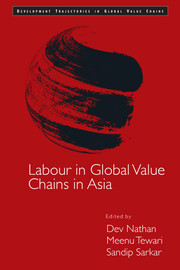1 - Introduction
from Introduction
Published online by Cambridge University Press: 23 July 2017
Summary
Since the 1970s and 1980s, Asia, and especially China, has become the factory of the world. To a lesser extent, India has become the back office of the world. These momentous shifts in the location of global economic activity have fuelled economic growth in the emerging economies of Asia: between 1995 and 2009 income from global value chains (GVCs)-related trade increased 6-fold for China and 5-fold for India (OECD, WTO, UNCTAD, 2011). The GVC trade accounts for about 30 per cent of GDP of developing countries (UNCTAD, 2011). Many of the new employees in GVCs, whether engaged in electronics, garments or IT services, include large numbers of women, which evokes notions of transformation in Asian labour markets. Poverty in developing Asia has also decreased: it is in single digit figures in East and Southeast Asia, though most of South Asia still lags behind, with poverty levels at three times or more than those found in East and Southeast Asia (World Bank, 2014).
In the midst of this unparalleled growth and transformation, there are all-too-frequent stories of disasters—whether of suicides by workers in China in electronic assembly factories or of fires and factory collapses in Bangladesh—that kill hundreds of workers. In the midst of unprecedented advances, there are also serious problems and the benefits of GVC-led growth are deeply uneven. It is thus necessary to ask how and to what extent labour has benefited from the advances of firms and economies in both manufacturing and service production in the developing countries of Asia. Who benefits and why, who does not and why not? What are the reasons that limit these benefits? And, going forward, how can labour in Asia benefit more substantially from economic growth in the region?
These are some of the questions that motivate this book. The book is itself a product of a larger research collaboration on the study of economic and social upgrading in GVCs as part of the Capturing the Gains (CtG) initiative. The CtG project brought together a large network of scholars who carried out research on these themes in a number of countries and sectors. In this book, however, we also include some studies that were not part of the CtG Project but became part of the larger collaboration it fostered.
Information
- Type
- Chapter
- Information
- Labour in Global Value Chains in Asia , pp. 3 - 28Publisher: Cambridge University PressPrint publication year: 2016
